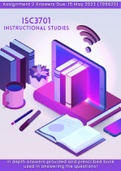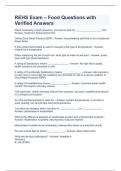ISC3701
Instructional studies
,SECTION 1: OVERVIEW OF THE LEARNING THEORY
1.1 This module introduces you to various learning theories. Name three
learning theories and explain at least three key characteristics of each. (15)
Behaviourism is a learning theory that emerged in the early 20th century and
emphasizes the role of the environment in shaping behaviour. According to this
theory, learning is a process of stimulus-response association, in which an external
stimulus elicits a particular response from an organism. Reinforcement and
punishment are the primary mechanisms that shape behaviour. Reinforcement
involves providing a consequence that increases the likelihood of a behaviour being
repeated, while punishment involves providing a consequence that decreases the
likelihood of a behaviour being repeated.
Behaviourism has been widely applied in educational settings, particularly in the form
of operant conditioning. In operant conditioning, behaviours are shaped through
positive or negative reinforcement, which can take many forms such as praise,
rewards, or grades. However, critics of behaviourism argue that it is too focused on
observable behaviour and does not take into account the internal processes of the
learner, such as thoughts and emotions.
Key characteristics of behaviourism include:
• Learning is seen as a process of stimulus-response association, in which an
external stimulus elicits a particular response from an organism.
• Reinforcement and punishment are the primary mechanisms that shape
behaviour.
• The focus is on observable behaviour rather than internal mental processes.
Examples of behaviourism in action include:
• A teacher using positive reinforcement to encourage a student to participate in
class by praising them for their contributions.
• A parent using negative reinforcement to discourage a child from engaging in
a particular behaviour by taking away a privilege or imposing a consequence.
3
, • A coach using punishment to discourage a player from engaging in a
particular behaviour by benching them or imposing extra training.
Critics of behaviourism argue that it is too focused on observable behaviour and
does not take into account the internal processes of the learner, such as thoughts
and emotions. However, behaviourism has been widely applied in educational
settings, particularly in the form of operant conditioning. In operant conditioning,
behaviours are shaped through positive or negative reinforcement, which can take
many forms such as praise, rewards, or grades.
Constructivism is a learning theory that emphasizes the active role of the learner in
constructing their own understanding of the world. According to this theory, learning
is a process of building new knowledge and skills on top of existing ones. Learners
are seen as active agents who construct their own knowledge through a process of
assimilation and accommodation. Assimilation involves incorporating new
information into existing mental frameworks, while accommodation involves
modifying existing frameworks to fit new information.
Constructivism has been widely applied in educational settings, particularly in the
form of collaborative and inquiry-based learning. These approaches emphasize
social interaction and collaboration, as learners construct new knowledge through
discussion, debate, and the sharing of perspectives. However, critics of
constructivism argue that it can be difficult to assess learning outcomes in such
open-ended learning environments, and that it may not be appropriate for all
learners.
Cognitive Load Theory Cognitive Load Theory is a learning theory that emphasizes
the importance of managing cognitive load in learning. According to this theory,
learning is a process of organizing and integrating new information with prior
knowledge. However, different types of information require different levels of
cognitive processing, and cognitive overload can impede learning. Cognitive Load
Theory proposes that learning can be optimized by managing the cognitive load of
learners, through techniques such as simplifying complex information, using visual
aids, and providing scaffolding.
4





